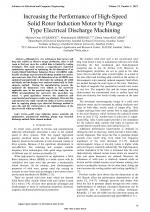| 1/2023 - 9 |
Increasing the Performance of High-Speed Solid Rotor Induction Motor by Plunge Type Electrical Discharge MachiningGULBAHCE, M. O. |
| Extra paper information in |
| Click to see author's profile in |
| Download PDF |
Author keywords
solid rotor induction motor, axial-slit, slit optimization, parametrical modeling, plunge type electrical discharge method, finite element method
References keywords
rotor(27), solid(20), speed(18), induction(18), high(17), motor(10), power(9), electronics(9), pyrhonen(7), design(7)
Blue keywords are present in both the references section and the paper title.
About this article
Date of Publication: 2023-02-28
Volume 23, Issue 1, Year 2023, On page(s): 79 - 86
ISSN: 1582-7445, e-ISSN: 1844-7600
Digital Object Identifier: 10.4316/AECE.2023.01009
Web of Science Accession Number: 000937345700009
SCOPUS ID: 85150187080
Abstract
Although it is very well-known that narrow and deep slits exhibit an effective torque production, there is still room to find out, since the verified data is limited by tooling techniques. This study presents a comprehensive numerical optimization approach on optimizing the slit dimensions of an Axially-Slitted Solid Rotor Induction Motor (AS-SRIM) while benefits of plunge type electrical discharge method was used to open narrower slots. First, slit dimensions of an AS-SRIM were optimized parametrically to determine the optimum slit width and depth, and the designs were analyzed numerically by finite elements method. During the manufacturing process, the optimized slit dimensions were shifted to the narrowest applicable ones. In the practical stage of the study, the AS-SRIM accommodating the narrowest slits up-to-date was tested. A good agreement between the numerical and experimental performance results was obtained. All-in-all, this experimental case study extends the limits of known practical data by applying plunge type electrical discharge method to open slits and the crucial point is the implementation of the narrowest slit width up-to-date. |
| References | | | Cited By |
Web of Science® Times Cited: 2 [View]
View record in Web of Science® [View]
View Related Records® [View]
Updated today
SCOPUS® Times Cited: 2
View record in SCOPUS® [Free preview]
View citations in SCOPUS® [Free preview]
[1] Investigational Analysis and Experimental Study of a 3-phase Induction Motor for Electric Bike Application, Tak, Ansh, Makwana, Shivom, Patel, Manish, Yagnik, Riddhesh, International Journal of Innovative Science and Research Technology (IJISRT), ISSN 2456-2165, 2024.
Digital Object Identifier: 10.38124/ijisrt/IJISRT24APR1464 [CrossRef]
[2] A comprehensive overview of high-speed solid-rotor induction machines: Applications, classification, and multi-physics modeling, Bilek, Vladimir, Barta, Jan, Toman, Marek, Losak, Petr, Bramerdorfer, Gerd, International Journal of Electrical Power & Energy Systems, ISSN 0142-0615, Issue , 2025.
Digital Object Identifier: 10.1016/j.ijepes.2025.110520 [CrossRef]
[3] Induction Motor Geometric Parameter Optimization Using a Metaheuristic Optimization Method for High-Efficiency Motor Design, Apaydin, Hasbi, Oyman Serteller, Necibe Füsun, Oğuz, Yüksel, Energies, ISSN 1996-1073, Issue 3, Volume 18, 2025.
Digital Object Identifier: 10.3390/en18030733 [CrossRef]
Disclaimer: All information displayed above was retrieved by using remote connections to respective databases. For the best user experience, we update all data by using background processes, and use caches in order to reduce the load on the servers we retrieve the information from. As we have no control on the availability of the database servers and sometimes the Internet connectivity may be affected, we do not guarantee the information is correct or complete. For the most accurate data, please always consult the database sites directly. Some external links require authentication or an institutional subscription.
Web of Science® is a registered trademark of Clarivate Analytics, Scopus® is a registered trademark of Elsevier B.V., other product names, company names, brand names, trademarks and logos are the property of their respective owners.
Faculty of Electrical Engineering and Computer Science
Stefan cel Mare University of Suceava, Romania
All rights reserved: Advances in Electrical and Computer Engineering is a registered trademark of the Stefan cel Mare University of Suceava. No part of this publication may be reproduced, stored in a retrieval system, photocopied, recorded or archived, without the written permission from the Editor. When authors submit their papers for publication, they agree that the copyright for their article be transferred to the Faculty of Electrical Engineering and Computer Science, Stefan cel Mare University of Suceava, Romania, if and only if the articles are accepted for publication. The copyright covers the exclusive rights to reproduce and distribute the article, including reprints and translations.
Permission for other use: The copyright owner's consent does not extend to copying for general distribution, for promotion, for creating new works, or for resale. Specific written permission must be obtained from the Editor for such copying. Direct linking to files hosted on this website is strictly prohibited.
Disclaimer: Whilst every effort is made by the publishers and editorial board to see that no inaccurate or misleading data, opinions or statements appear in this journal, they wish to make it clear that all information and opinions formulated in the articles, as well as linguistic accuracy, are the sole responsibility of the author.



